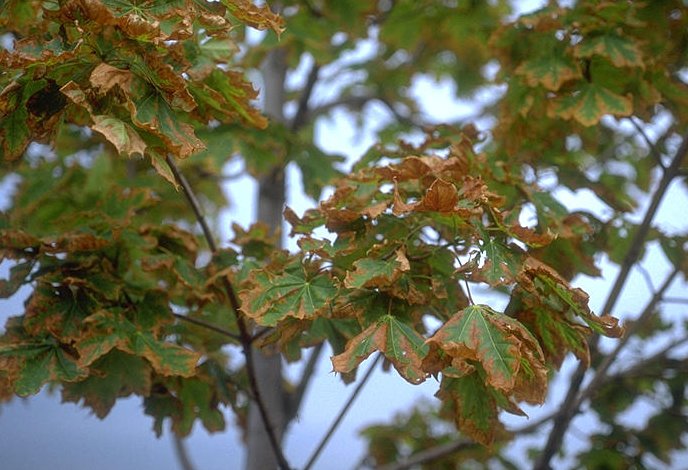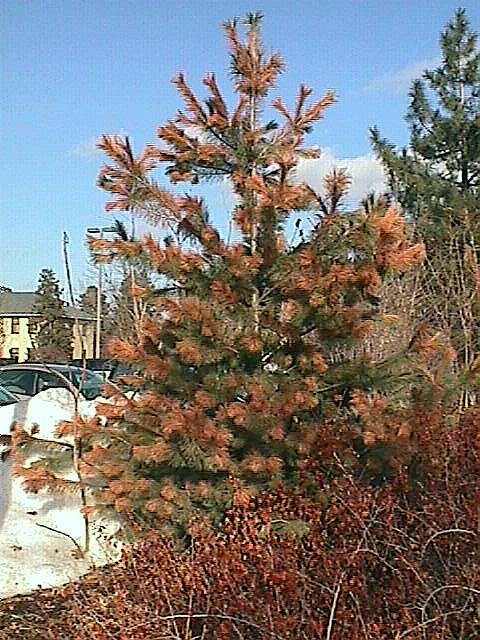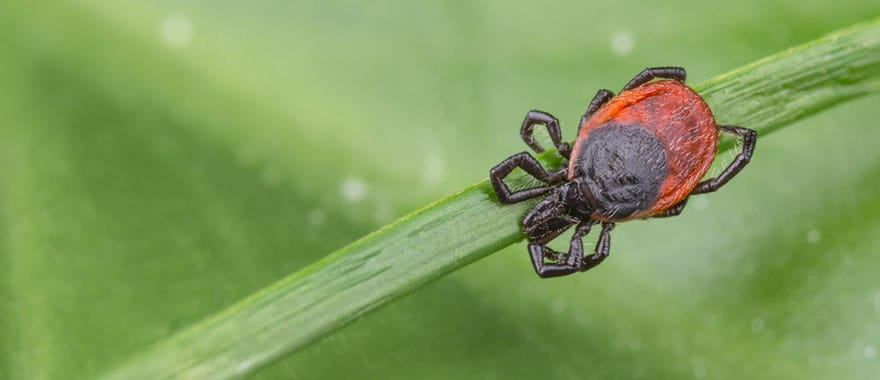Many trees and shrubs can be disfigured and killed by road salt (Sodium Chloride or Calcium Chloride). Sodium Chloride is used primarily since it’s less expensive but it’s also more damaging to plants. Late season applications of salt are more harmful to trees since there is less time and run off to leach salt from the soils near root zones.
The worst damage occurs to sensitive tree species planted near heavily salted roads with high traffic, especially when they lie downhill, downwind, or have poor drainage.
Salts cause tree damage two ways:
- Direct contact with foliage (spray zone damage) which is typically seen on evergreens along roadways.
- Through chemical modification of the soil where plants uptake salt ions through the root system which then reaches toxic levels and scorches the foliage.
Uptake of the salt ion also slows tree growth and increases stress by interfering with nutrient availability.

Salt damage on sugar maple
How to Recognize Salt Damage on Trees
- Winter: Look for “witch’s brooms” (cluster of twigs growing out of branch ends) on deciduous trees, yellow tips on evergreen needles.
- Early Summer: Look for marginal leaf scorch on deciduous trees, and yellow, brown, or fallen needles on evergreens–especially on the side toward the road.
- Other problems can produce the same symptoms, so examine the whole plant and site carefully to rule out other causes.
Trees Commonly Damaged by Road Salt
- red maple (Acer rubrum)
- sugar maple (A. saccharum)
- hackberry (Celtis occidentalis)
- black walnut (Juglans nigra)
- Norway spruce (Picea abies)
- white spruce (P. glauca)
- white pine (Pinus strobus)
- Douglas fir (Pseudotsuga menziesii)
- pin oak (Quercus palustris)
- littleleaf linden (Tilia cordata)

Salt spay on evergreens
What to do About Salt Damage on Trees
- Plant salt-tolerant species such as ashes, callery pears, ginkgo, hawthorns, honeylocust, London plane, tolerant maples (Norway, hedge, or sycamore), English and red oak, tolerant pines (Austrian, pitch, or Japanese black), Sargent cherry, or Scholar Tree.
- Reduce salt application rates, lower the throwing distance, and apply before roads freeze.
- Use a less harmful product such as CMA or IcebanTM, and mix in inert materials like sand.
- Wash salts off foliage with fresh water soon after exposure.
- Avoid piling snow containing salt around plants or where runoff will effect plants.
- Raise the planting site, or block off the trees from the road with a barrier.
- Improve drainage or adjust grade, so salt is easily leached away from trees.
- Leach salts from soil in root zone area by repeating applications of fresh water after the ground is no longer frozen. This is probably the most effective way to reduce soil salinity problems.
- Incorporating organic matter like gypsum or activated charcoal has been found to reduce salt damage in some cases but is a slow process.
For further information on this subject the CT Agricultural Experiment Station published a paper on this. Click here



